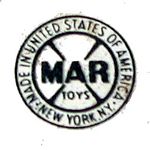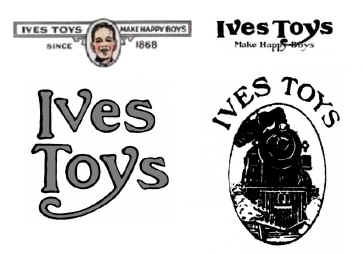|
Who Made That Toy?
One of the first questions a toy collector usually
asks is, " Who made it?" Part of the fun of collecting is
researching a toy and learning more about it. But you need a place
from which to start, so here are few facts about patents,
characteristics and identification of marks that may help.
Only a few U.S. toys were patented before the
mid-1800s. After 1870 most were patented or trademarked. If the toy
has a stenciled, embossed or printed patent number on it or its
original box, it can be verified by its inventor and manufacturer by
the U.S. Patent office. However, patent dates can be misleading, since
patent rights can be purchased and toys can be manufactured for many
years afterwards.
 In
compliance with the McKinley tariff Act of 1891, all foreign-made toys
had to be marked with a country of origin. There were many toy
manufacturers in Europe, especially in Germany, and a lot of German
toys ended up in America. In
compliance with the McKinley tariff Act of 1891, all foreign-made toys
had to be marked with a country of origin. There were many toy
manufacturers in Europe, especially in Germany, and a lot of German
toys ended up in America.
Some of the best sources for identifying unmarked
toys are manufacturer's wholesale and retail catalogs, flyers, job
lists and order forms, toy organizations and museums. Many times
examples are advertised in toy trade journal such as Antique Toy
World and Collector's Showcase.
There can be a lot of confusion in attempts to
identify a toy. For instance, George Borgfeldt marketed many toys
under a "no name" line and was also the American
representative for Steiff and Nifty toys and the New York broker for
Gibbs Mfg. of Canton, Ohio. The Harris Toy Co. of Cleveland performed
work for their competition, Dent, Hubley, and Wilkens. In their early
years, Hubley made all kinds of spare parts for other companies.
The study of toys spans many years and hundreds of
manufacturers who were in and out of the business in many forms,
reorganizing several times over the course of their existence. It is
difficult in this publication to address them all, but some of the
major ones can be covered here.
The Arcade Manufacturing Co. was established in
Freeport, Illinois in 1868. Originally it was called Novelty Iron
Works. Their slogan was "They Look Real." Yellow Cab was
their first successful toy, and Andy and Chester Gump toys are still
popular with collectors. Arcade also made toy banks, dollhouse
furniture, and cast-iron penny toys. Its mark was a horizontal oval
with "ARCADE TOYS" and "They Look Real."
 The
company that made Buddy "L" toys was known under several
names beginning with Moline Press Steel and ending with the Buddy
"L" Corp. Buddy "L" toys started with a small
pressed pickup truck and expanded to a veritable fleet of 30 cranes,
steamrollers, trucks, and other construction equipment. The
company that made Buddy "L" toys was known under several
names beginning with Moline Press Steel and ending with the Buddy
"L" Corp. Buddy "L" toys started with a small
pressed pickup truck and expanded to a veritable fleet of 30 cranes,
steamrollers, trucks, and other construction equipment.
The Francis W. Carpenter Company of Port Chester,
NY manufactured several outstanding toys through the first decade of
the century. For the most part they made cast iron horse-drawn
vehicles (including the crème de la crème for many collectors) the
tally-ho. They sold many of their patent rights to Pratt and
Letchworth.
The Dent Hardware Company of Fullerton, PA had a
specialty of cast-iron and aluminum transportation toys and banks.
They made the Pioneer fire truck, the Ford Tri-Motor and large hook
and ladder toys.
"They're Different" was the slogan of
Lancaster, Pennsylvania's Hubley Manufacturing Co. They first made
cast-iron toys, horse-drawn wagons, and fire engines, circus trains,
and cap guns. Hubley used the name Lancaster Brand Iron Toys. During
the Depression they avoided financial woes by changing to the
manufacturer of cheaper, smaller toys. Their specialty was electric
toy train equipment and parts.
The Ives Corporation made the finest of cast-iron
toys in the late 1800's and early 1900's, and fine clockwork toys.
Clockwork toys were the Rolls Royce of motion toys, since they used
brass clock mechanisms, rather than a windup mechanism, to give the
toys motion. Ives used two different marks. One was the face of a boy
in an oval with the words "IVES TOYS MAKE HAPPY BOYS." The
other was an oval with the front view of a locomotive with the words
"IVES TOYS" above it. Lionel took over the company during
the Depression.
The Kenton Hardware Co. of Kenton, Ohio began toy
manufacturing in 1894 with horse-drawn fire equipment, banks, and toy
stoves. Their slogan was "The Real Thing In Everything But
Size." Kenton's mark was the bold letters KT with "KENTON
TOYS" overlaid on them inside an elongated octagon.
Louis Marx & Co. originally placed large orders
with Girard Model Works, Strauss, and C.G. Wood, who produced toys
under the Marx trademark. They specialized in tin windup toys and were
one of the Big 4 among electric train manufacturers.
Pratt & Letchwork of Buffalo, NY was originally
known as Buffalo Malleable Iron and made fine cast iron horse drawn
hansom cabs, pumpers, artillery wagons, and toy trains
One of the few West Coast manufacturers was the
Smith Miller Company of Santa Monica CA., but they didn't begin until
the 1940's. Nevertheless they made very collectible Mack truck pressed
steel toys.
Stevens & Brown made quality tin toys that were
soldered rather than having a tab and slot construction.
These are some identifying marks, features, and
characteristics of but a few makers. The field is so vast that we
recommend some study before any major purchase is made. Of course, if
you find an inexpensive toy that you just can't resist, you can always
hope you've discovered a very fine collectible! |